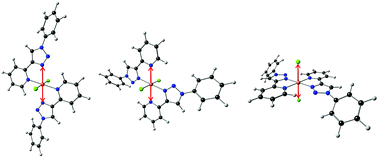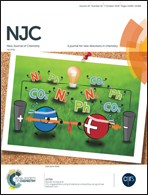Jahn–Teller distortion in 2-pyridyl-(1,2,3)-triazole-containing copper(ii) compounds†
Abstract
The syntheses, characterization and experimental solid state X-ray structures of five low-spin paramagnetic 2-pyridyl-(1,2,3)-triazole-copper compounds, [Cu(Ln)2Cl2], are presented in this study, for the following five Ln ligands: L1 = 2-(1-(p-tolyl)-1H-(1,2,3-triazol-4-yl)pyridine), L2 = 2-(1-(4-chlorophenyl)-1H-(1,2,3-triazol-4-yl)pyridine), L3 = 4-(4-(pyridin-2-yl)-1H-(1,2,3-triazol-4-yl)benzonitril), L4 = 2-(1-phenyl-1H-(1,2,3-triazol-4-yl)pyridine) and L5 = 2-(1-(4-(trifluoromethyl)phenyl)-1H-(1,2,3-triazol-4-yl)pyridine). These five [Cu(Ln)2Cl2] complexes each contain two bidentate 2-pyridyl-(1,2,3)-triazole (Ln) and two chloride ions as ligands, with the Cu–N(pyridine) bonds, Cu–N(triazole) and Cu–Cl bonds trans to each other. All five [Cu(Ln)2Cl2] compounds display elongation Jahn–Teller distortion, either along opposite Cu–N(triazole) bonds, or along opposite Cu–Cl bonds, as indicated by their obtained solid state crystal structures. Quantum chemistry calculations, using density functional theory, indicated however that elongation Jahn–Teller distortion is in fact possible along any two opposite bonds in these octahedral compounds with the elongation distortion along the opposite Cu–N(triazole) bonds being the most stable structure.



 Please wait while we load your content...
Please wait while we load your content...